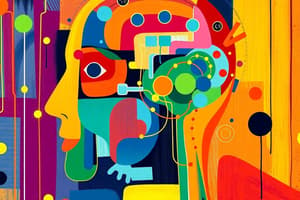Podcast
Questions and Answers
What is the primary goal of machine learning?
What is the primary goal of machine learning?
- Enabling computers to learn from data. (correct)
- Designing computer hardware.
- Programming computers to follow explicit instructions.
- Creating complex software applications.
Which of the following is a key characteristic of supervised learning?
Which of the following is a key characteristic of supervised learning?
- The algorithm learns without any human supervision.
- Training data includes desired solutions. (correct)
- Training data is unlabeled.
- The system learns incrementally from data.
A spam filter distinguishing between spam and non-spam emails is an example of which type of task?
A spam filter distinguishing between spam and non-spam emails is an example of which type of task?
- Classification (correct)
- Anomaly detection
- Regression
- Clustering
What type of Machine Learning system can adapt to new data?
What type of Machine Learning system can adapt to new data?
In which learning approach does the system learn incrementally from a stream of incoming data?
In which learning approach does the system learn incrementally from a stream of incoming data?
Flashcards
What is Machine Learning?
What is Machine Learning?
Machine Learning is the science and art of programming computers so they can learn from data without being explicitly programmed.
Mitchell's Definition of Learning
Mitchell's Definition of Learning
A computer program learns from experience E with respect to task T and performance measure P if its performance on T improves with E.
Online Learning
Online Learning
Machine Learning system learns incrementally from a stream of incoming data.
Batch Learning
Batch Learning
Signup and view all the flashcards
Instance-Based Learning
Instance-Based Learning
Signup and view all the flashcards
Study Notes
- Machine Learning (ML) involves programming computers so they can learn from data.
- ML is a field of study providing computers with the ability to learn without explicit programming.
- A computer program learns from experience E with respect to task T and performance measure P if its performance on T, measured by P, improves with experience E.
- If spam filters were created traditionally, it would involve noticing spam-like words, creating a detection algorithm, and repeating until good enough.
Why to Use Machine Learning
- Useful for the problems with hand-tuning or long lists of rules, one Machine Learning algorithm can often simplify code and perform better.
- Useful for complex problems with no traditional solution, Machine Learning identifies one.
- Useful for fluctuating environments where a Machine Learning system can adapt to data.
- Useful for insights about complex problems and large amounts of data.
Types of Machine Learning Systems
- Can be classified based on whether they are trained with human supervision.
- Can be classified based on whether they can learn incrementally on the fly.
- Can be classified based on how new data points are compared to existing ones.
Supervised Learning
- Algorithms use training data that includes desired solutions, as seen in classification tasks such as spam filters learning to classify new emails.
- Another typical task is predicting a target numeric value, called regression.
- The most important supervised learning algorithms are k-Nearest Neighbors, Linear Regression, Logistic Regression, Support Vector Machines (SVMs), Decision Trees and Random Forests, and Neural networks2.
Unsupervised Learning
- Algorithms utilize unlabeled training data, focusing on learning without a teacher.
- The unsupervised learning algorithms include Clustering, K-Means, DBSCAN, Hierarchical Cluster Analysis (HCA), Anomaly detection and novelty detection, One-class SVM, and Isolation Forest.
Semi-Supervised Learning
- Algorithms deal with partially labeled training data, typically a lot of unlabeled and a little labeled data.
Reinforcement Learning
- Involves a learning system (agent) that observes, selects, and performs actions in an environment.
- The agent receives rewards (or penalties) and learns a policy to maximize rewards over time.
Batch Learning
- Systems cannot learn incrementally and must be trained using all available data.
- This is often done offline due to time and computing resource demands, also called offline learning.
Online Learning
- Systems train incrementally by feeding data instances sequentially in mini-batches.
- Each learning step is fast and cheap.
Instance-Based Learning
- System learns the examples by heart.
- System generalizes to new cases by comparing them to the learned examples.
Model-Based Learning
- Generalization proceeds by building a model from a set of examples.
- The model is then used to make predictions.
Main Challenges of Machine Learning
- Insufficient data.
- Nonrepresentative training data.
- Poor quality data.
- Irrelevant features.
- Overfitting the training data.
- Underfitting the training Data.
- Testing and Validating.
Studying That Suits You
Use AI to generate personalized quizzes and flashcards to suit your learning preferences.




